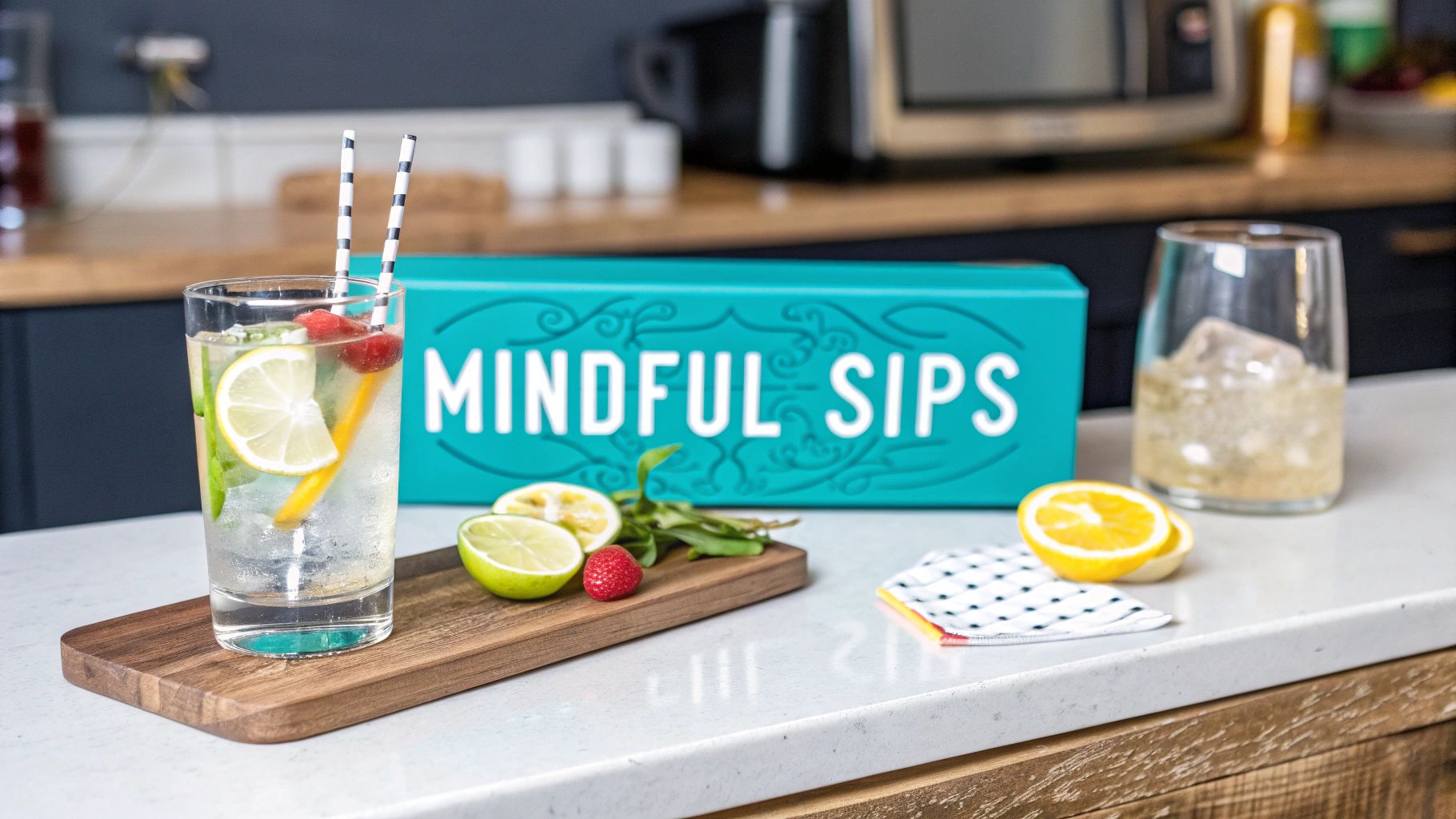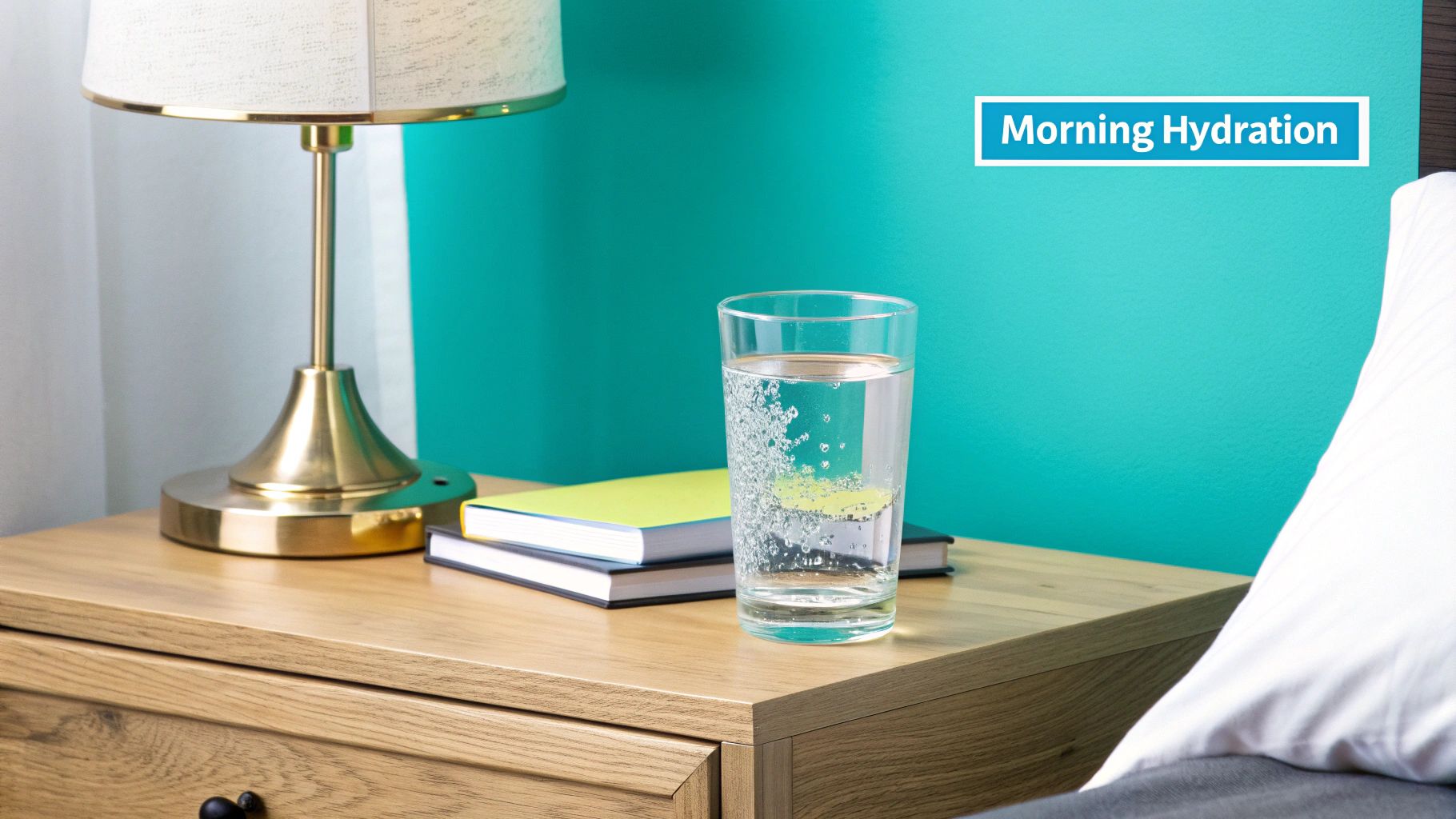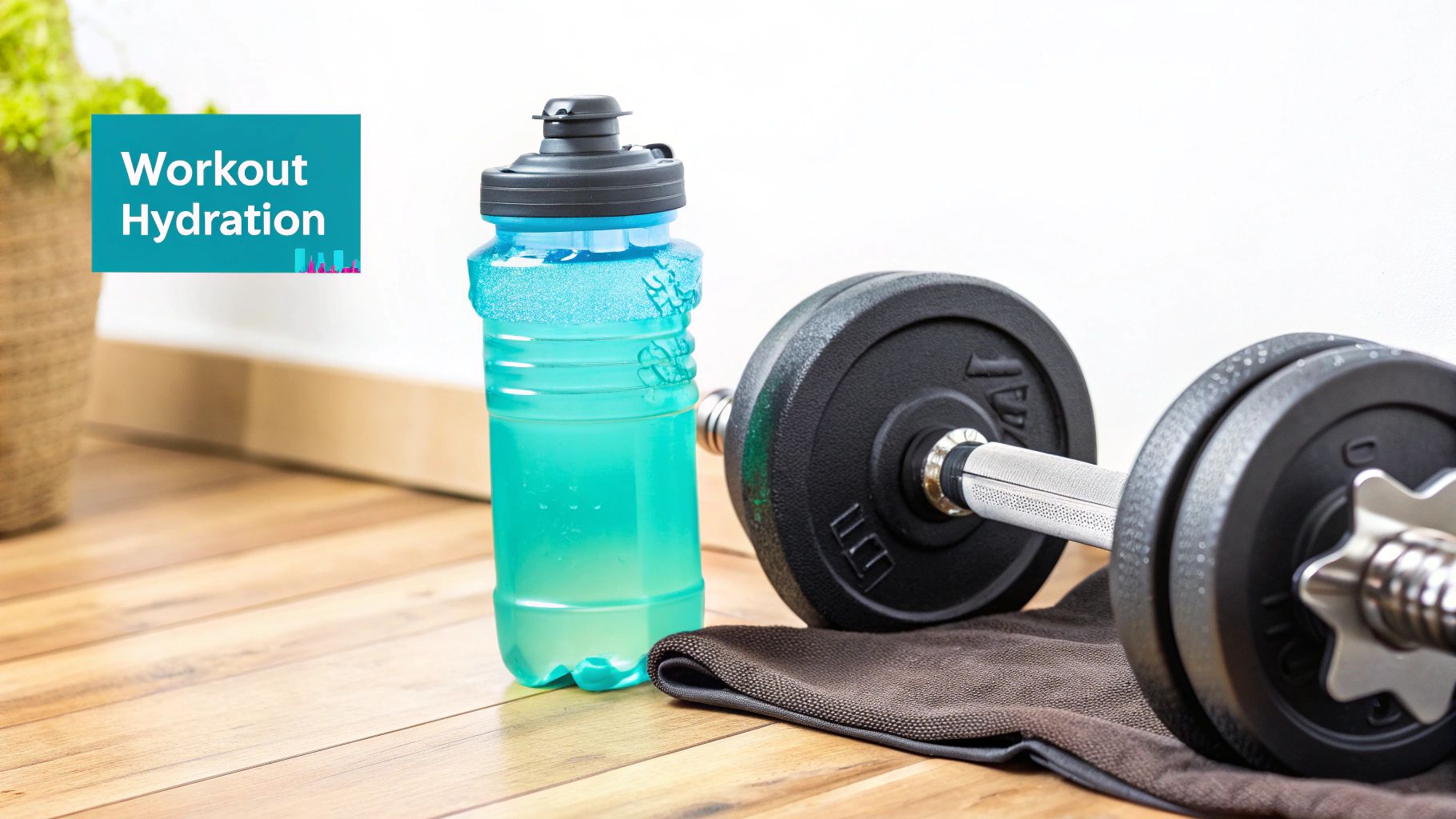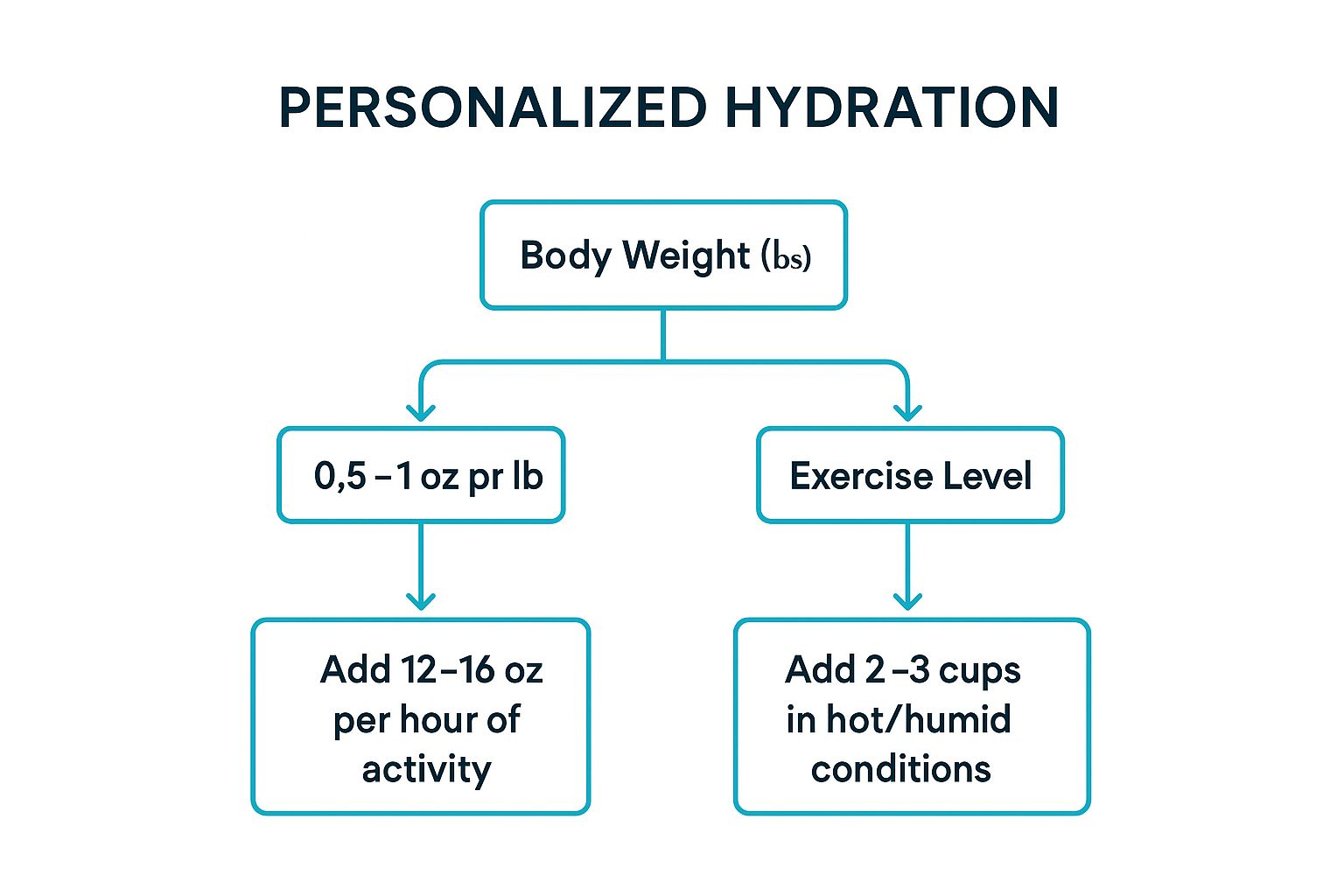

· By Annemarie
10 Healthy Drinking Habits to Boost Your Wellness
Redefining 'Happy Hour': The Modern Guide to Mindful Drinking
Enjoying a drink is a common thread in social gatherings, celebrations, and moments of relaxation. Yet, the line between moderate enjoyment and overindulgence can often feel blurry, with the consequences ranging from sluggish mornings to long-term health concerns. The key isn't necessarily abstinence but rather a smarter, more mindful approach. Developing healthy drinking habits is about empowering yourself with practical strategies to enjoy alcohol on your own terms, without sacrificing your well-being or productivity the next day. This guide moves beyond the generic advice to "drink less," offering a comprehensive toolkit for the modern drinker.
This listicle provides actionable, science-backed methods to integrate into your routine. You will learn precise hydration tactics, how to choose beverages that work for you instead of against you, and strategic nutritional choices that support your body's natural processes. We will explore how to prepare for a night out and how to recover effectively, incorporating tools like Upside Hangover Sticks to replenish essential nutrients. By adopting these mindful practices, you can redefine what a "happy hour" truly means: enjoying the present moment while respecting your future self. Let's dive into the habits that will transform your relationship with alcohol.
1. Drinking Water First Thing in the Morning
One of the most foundational healthy drinking habits has nothing to do with alcohol and everything to do with what you consume first. Starting your day by drinking a significant amount of water immediately upon waking rehydrates your body after a long night of reparative processes, which use up your water reserves. This practice, known as front-loading your hydration, sets your body up for optimal function throughout the day, especially if you plan on consuming alcohol later.

This simple habit isn't a modern fad; it has deep roots in various cultures. In Japan, the practice of Mizunomiryōhō (water therapy) involves drinking several glasses of room-temperature water on an empty stomach. Similarly, Ayurvedic tradition recommends drinking water, often stored overnight in a copper vessel, to cleanse the digestive tract and stimulate metabolism. Even modern high-performers like Tony Robbins advocate for this, reportedly drinking 32 ounces of water with sea salt each morning to replenish minerals and rehydrate.
How to Implement This Habit
Making this a consistent part of your routine is key. It primes your system, aids in flushing out toxins, and can even help distinguish true hunger from thirst, potentially preventing overeating.
- Make it convenient: Keep a large, filled water bottle on your nightstand. Seeing it first thing in the morning serves as an immediate visual cue.
- Start small: If 16-32 ounces feels daunting, begin with 8 ounces and gradually increase the amount over a week or two as your body adjusts.
- Enhance the flavor: If you find plain water unappealing, add a squeeze of fresh lemon, a few cucumber slices, or a sprig of mint.
- Time your breakfast: For maximum benefit, wait at least 30 minutes after drinking your water before eating. This allows your digestive system to fully awaken and absorb the water efficiently.
2. Following the 8x8 Rule (8 Glasses of 8 Ounces)
While front-loading your water is an excellent start, maintaining hydration throughout the day is crucial for overall wellness and one of the most fundamental healthy drinking habits. The "8x8 rule" offers a simple, memorable guideline: aim to drink eight 8-ounce glasses of water daily, totaling 64 ounces (about 2 liters). This consistent intake helps your body manage everything from metabolism to cognitive function, and it’s especially vital when preparing for or recovering from alcohol consumption.
This rule has become a public health staple for its simplicity. It's the default goal in many fitness apps like MyFitnessPal and is frequently taught in corporate wellness programs and school health classes because it provides a clear, measurable target. While individual needs vary based on factors like climate, activity level, and body size, the 8x8 rule serves as an excellent baseline for the average person to ensure they are adequately hydrated.
How to Implement This Habit
Integrating this rule into your daily life is about creating a system for consistent hydration, which helps dilute alcohol's effects and supports your liver.
- Use a marked water bottle: A bottle with time or ounce markers provides a visual guide to track your progress and pace your intake throughout the day.
- Set hourly reminders: Use your phone or smartwatch to set an alarm that prompts you to drink a glass of water every hour or so.
- Listen to your body: While 64 ounces is a good goal, pay attention to thirst signals and urine color. Pale yellow indicates good hydration, while darker yellow means you need more water.
- Adjust for activity: On days you exercise or spend time in the heat, make a conscious effort to drink more than the standard 64 ounces to replenish lost fluids.
3. Mindful Hydration Throughout the Day
Building on the morning routine, another cornerstone of healthy drinking habits is maintaining consistent hydration all day long. This involves consciously monitoring your body's needs and drinking water regularly, rather than waiting for the obvious signal of thirst, which often indicates you're already dehydrated. Maintaining this constant state of optimal hydration is crucial, as it supports everything from cognitive function to organ health, and significantly fortifies your system against the dehydrating effects of alcohol.

This proactive approach is championed by sports nutritionists and wellness coaches who understand that peak performance relies on steady hydration. Athletes sip water every 15-20 minutes during training, not just when they feel parched. This principle applies beyond athletics; tech workers set hourly reminders to counteract the dry office air, and teachers keep water bottles at their desks for continuous sips. The goal is to never let your body's water levels dip, creating a resilient internal environment.
How to Implement This Habit
Integrating mindful hydration into your daily schedule prevents the energy slumps and headaches associated with dehydration, ensuring you feel your best.
- Utilize technology: Set recurring alarms on your phone or use dedicated apps like WaterMinder or Hydro Coach to provide consistent reminders.
- Create habit triggers: Link drinking water to existing routines. Take a few sips every time you check your email, after a bathroom break, or before each meal.
- Keep water visible: Always have a water bottle on your desk, in your bag, or in your car. This visual cue makes it easy and convenient to drink more.
- Monitor your progress: A simple, effective way to gauge hydration is by checking your urine color. Aim for a pale, straw-like color, which is a reliable indicator of good hydration.
4. Limiting Sugary and Alcoholic Beverages
A critical component of developing healthy drinking habits involves consciously reducing your intake of beverages laden with sugar and alcohol. These drinks, including sodas, sweetened cocktails, energy drinks, and many commercial juices, can spike your blood sugar, contribute to weight gain, and lead to dehydration, which exacerbates the negative effects of alcohol. By moderating your consumption of both, you support more stable energy levels, better hydration, and overall metabolic health, creating a more resilient system for when you do choose to drink alcohol.
This principle is widely endorsed by major health bodies like the American Heart Association and the World Health Organization, which highlight the risks of excessive sugar and alcohol. We see this practice in action through cultural movements like "Dry January" or "Sober October," where individuals abstain from alcohol to reset their habits. Similarly, many corporate wellness programs now remove sugary sodas from vending machines, and athletes meticulously avoid both during their training seasons to optimize performance and recovery.
How to Implement This Habit
Making mindful beverage choices is a powerful habit that significantly reduces your intake of empty calories and metabolic stressors. The goal is to replace, not just restrict.
- Read the labels: Be vigilant about checking nutrition labels on mixers and pre-packaged drinks. Sugar often hides under names like high-fructose corn syrup, dextrose, or cane juice.
- Embrace sparkling water: Use sparkling water with a splash of fruit juice or fresh muddled fruit as a base for cocktails or as a refreshing alternative to soda.
- Follow the 1:1 rule: For every alcoholic beverage you consume, drink a full glass of water. This slows your alcohol consumption rate and keeps you hydrated.
- Find non-alcoholic favorites: Socializing doesn't have to revolve around alcohol. Exploring enjoyable alternatives can make a significant difference. For some great ideas, explore these healthy and tasty options to drink instead of alcohol on enjoyupside.com.
5. Pre and Post-Workout Hydration
A crucial, yet often overlooked, component of healthy drinking habits involves strategically managing your fluid intake around physical activity. When you exercise, especially if you plan to have a drink later, your body loses significant water and electrolytes through sweat. Failing to replenish these can lead to dehydration, which impairs performance, delays recovery, and intensifies the effects of alcohol. A proper pre and post-workout hydration strategy ensures your body remains balanced and resilient.

This methodical approach to hydration is standard practice among elite athletes and has been popularized by organizations like the American College of Sports Medicine. Marathon runners, for instance, meticulously follow hydration station protocols, while professional sports nutritionists create personalized fluid plans for their clients. The goal is to start exercise fully hydrated, maintain that status as much as possible, and then effectively rehydrate afterward to restore balance. This principle is just as vital for a gym-goer as it is for an Olympic cyclist.
How to Implement This Habit
Integrating a structured hydration plan around your workouts will optimize both your fitness and your body’s ability to process alcohol. This habit is key for maintaining energy levels and supporting metabolic function.
- Hydrate Beforehand: Drink 16-20 ounces of water two to three hours before your workout. This gives your body time to absorb the fluid and your kidneys time to process any excess.
- Drink During Exercise: For every 15-20 minutes of activity, aim to consume 6-12 ounces of fluid. If your workout exceeds one hour, consider a drink with electrolytes.
- Measure and Replenish: A simple way to gauge fluid loss is to weigh yourself before and after your workout. For every pound lost, you should aim to drink 16-24 ounces of fluid to rehydrate. Discover more about the best ways to rehydrate with these proven science tips.
- Keep it Cool: Studies suggest that cooler water (around 50-59°F) is absorbed more quickly by the stomach, making it more effective for workout hydration.
6. Eating Water-Rich Foods
Effective hydration isn’t limited to what you drink; it’s also about what you eat. One of the most sustainable healthy drinking habits is incorporating foods with high water content into your daily diet. This strategy, often referred to as "eating your water," supplements your fluid intake and provides essential vitamins and minerals simultaneously. Foods like watermelon, cucumber, and oranges can contribute significantly to your overall hydration, making it easier to stay balanced, especially on days you plan to consume alcohol.
This concept is a cornerstone of many health-focused lifestyles. The Mediterranean diet, celebrated for its health benefits, is naturally high in water-rich fruits and vegetables. Athletes often turn to watermelon for its hydrating properties and natural electrolytes. Similarly, beauty and wellness experts frequently recommend foods like cucumbers and celery for their skin-hydrating benefits. Even a simple soup-based meal, common in many cultures, serves as a delicious and effective way to boost fluid levels before a night out.
How to Implement This Habit
Integrating water-rich foods is a simple, effective way to maintain hydration without constantly chugging water. It helps keep your cells hydrated and your body prepared to process alcohol more efficiently.
- Build a hydrating base: Start your main meals with a salad full of lettuce, tomatoes, and cucumbers, or a clear, broth-based soup.
- Snack smart: Choose fruits like oranges, grapes, melon, and berries for snacks instead of dry, processed options. Their high water content is refreshing and satiating.
- Enhance your meals: Add slices of tomato, cucumber, or bell peppers to sandwiches and wraps for an extra crunch and a boost of hydration.
- Create refreshing treats: Freeze grapes or blend watermelon with mint into slushies for a cool, hydrating snack on a warm day.
7. Temperature-Conscious Drinking
A frequently overlooked aspect of healthy drinking habits is the temperature of what we consume. The practice of temperature-conscious drinking involves choosing specific water temperatures to achieve different physiological goals. This isn't just about personal preference; it’s about strategically using temperature to enhance hydration, aid digestion, and support bodily functions, especially when preparing for or recovering from alcohol consumption.
This concept is central to many ancient wellness systems. Traditional Chinese Medicine (TCM), for example, strongly advocates for warm or room-temperature water to support the spleen and stomach's digestive "fire." Conversely, modern sports science has shown that athletes benefit from ice-cold water post-exercise for rapid core temperature reduction. Similarly, wellness spas often incorporate hydrotherapy, using contrasting water temperatures to stimulate circulation and promote detoxification. Aligning your water temperature with your body's needs is a subtle yet powerful health strategy.
How to Implement This Habit
By being mindful of temperature, you can optimize your body's response to hydration. This can be particularly beneficial before drinking alcohol, as a well-regulated system is better equipped to process it.
- Warm water for digestion: Start your day with warm water, perhaps with lemon, to gently awaken your digestive system. It's also ideal to drink warm or room-temperature water with meals to avoid hindering the digestive process.
- Cool water for exercise: During and after a workout, cool water is absorbed more quickly by the stomach, helping you rehydrate faster and cool down your internal body temperature.
- Use insulated bottles: To maintain your preferred temperature throughout the day, invest in a quality insulated bottle. This makes it easy to have warm or cool water ready whenever you need it.
- Listen to your body: Pay attention to how you feel. Sometimes your body may crave the soothing comfort of warm water, while other times a crisp, cool drink feels more invigorating.
8. Personalized Hydration Based on Individual Needs
The common advice to drink eight glasses of water a day is a helpful starting point, but true optimal hydration is highly personal. One of the most advanced healthy drinking habits involves customizing your fluid intake based on a unique combination of factors. This personalized approach considers your body weight, activity level, climate, and overall health, ensuring your hydration strategy is tailored specifically to you, not a generic guideline.
This concept is championed by sports medicine physicians and registered dietitians who understand that individual needs vary dramatically. For example, a pregnant woman may need an extra 10-13 ounces daily to support fetal development, while an office worker in a temperate climate has different requirements than a construction worker in the desert who might need a liter per hour in peak heat. Similarly, elderly individuals often need to consciously monitor intake due to a naturally decreasing thirst sensation, making a personalized plan crucial for preventing dehydration.
How to Implement This Habit
Adopting a personalized hydration plan helps maintain peak physical and cognitive function, especially when alcohol is involved, as it depletes fluids and essential minerals. Understanding what your body needs is the first step.
- Calculate your baseline: A common formula is to drink between 0.5 and 1 ounce of water for each pound of body weight. For a 150-pound person, this would be 75-150 ounces daily.
- Adjust for activity: Add 12-16 ounces of water for every hour of moderate to intense exercise. For prolonged or sweaty workouts, it's also important to replenish lost minerals. You can learn more about the role of electrolytes in hydration.
- Factor in your environment: If you live in or are traveling to a hot or humid climate, increase your daily intake by at least two to three cups.
- Monitor your output: Use urine color as a simple, real-time indicator. Pale yellow suggests good hydration, while dark yellow or amber is a clear sign you need to drink more fluids.
10. Understanding Your Personalized Hydration Needs
Hydration is a cornerstone of healthy drinking habits, but it's not a one-size-fits-all equation. A generic "eight glasses a day" recommendation often falls short because individual needs vary dramatically based on body weight, activity level, and environment. Understanding your specific requirements is crucial for effectively preparing your body for alcohol consumption and aiding its recovery. This tailored approach ensures your cells have the water they need to function optimally, especially when faced with the dehydrating effects of alcohol.
This infographic provides a simple decision tree to help you calculate a more accurate daily water intake goal, moving beyond generic advice to a personalized strategy.

The visualization demonstrates how quickly hydration needs can increase with just a few lifestyle or environmental adjustments, highlighting the importance of a dynamic approach. This personalized number is your baseline; on days you consume alcohol, which acts as a diuretic, aiming for the higher end of your range or slightly above it is a smart strategy.
How to Implement This Habit
Calculating and meeting your personalized goal is simpler than it sounds. It’s about creating awareness and building a responsive hydration plan that adapts to your daily life, especially on days involving social drinking.
- Calculate Your Baseline: Use the starting point of 0.5 to 1 ounce of water per pound of body weight. For a 150-pound person, this is 75-150 ounces (approx. 9-18 cups) per day.
- Adjust for Activity: Add 12-16 ounces of water for every hour of moderate to intense exercise. If you hit the gym before going out, this pre-hydration is vital.
- Factor in Your Environment: In hot or humid climates, or even in overly dry, air-conditioned offices, increase your daily intake by at least 2-3 cups to compensate for increased fluid loss.
- Track Your Intake: Use a water bottle with measurement markers or a simple tracking app for a day or two to get a realistic sense of your current consumption versus your personalized goal.
Top 10 Healthy Drinking Habits Comparison
| Hydration Method | Implementation Complexity 🔄 | Resource Requirements ⚡ | Expected Outcomes 📊 | Ideal Use Cases 💡 | Key Advantages ⭐ |
|---|---|---|---|---|---|
| Drinking Water First Thing in the Morning | Low to Moderate 🔄 | Minimal - plain water | Improved metabolism, detoxification, alertness 📊 | Daily routine starter, weight management | Quick rehydration, metabolic boost |
| Following the 8x8 Rule (8 Glasses) | Low 🔄 | Moderate - regular access to water | Baseline hydration, habit formation 📊 | Sedentary adults, general hydration guideline | Simple, easy to remember |
| Mindful Hydration Throughout the Day | Moderate to High 🔄 | Continuous water availability | Steady hydration, reduced fatigue 📊 | Active lifestyles, cognitive performance | Prevents dehydration proactively |
| Limiting Sugary and Alcoholic Beverages | Moderate 🔄 | Requires alternatives & awareness | Lower calories, improved metabolic health 📊 | Health improvement, weight control | Reduces empty calories and health risks |
| Pre and Post-Workout Hydration | Moderate to High 🔄 | Water + electrolytes | Enhanced performance & recovery 📊 | Athletes, intense exercise | Prevents cramps, supports endurance |
| Eating Water-Rich Foods | Low 🔄 | Access to fresh produce | Additional hydration + nutrition 📊 | Diet improvement, digestive health | Combines hydration with nutrients |
| Temperature-Conscious Drinking | Moderate 🔄 | May require temperature control | Optimized hydration & digestion 📊 | Exercise, digestion, seasonal adjustments | Enhances absorption, comfort |
| Personalized Hydration Based on Individual Needs | High 🔄 | Monitoring tools, professional input | Precise hydration, prevents over/underhydration 📊 | Special populations, varying climates | Tailored to individual physiology |
Your Blueprint for a Healthier Social Life
Navigating the world of social drinking doesn't have to be a zero-sum game where you sacrifice either your health or your enjoyment. Throughout this guide, we've explored a comprehensive toolkit of strategies designed to empower you. From the foundational principle of hydrating first thing in the morning to the nuanced art of mindful consumption, each habit builds upon the last, creating a powerful framework for a more balanced lifestyle. We’ve moved beyond generic advice, offering specific, actionable steps that integrate seamlessly into your daily and nightly routines.
The core message is one of proactive preparation and mindful moderation. It's not about eliminating alcohol but about fundamentally shifting your relationship with it. By mastering these healthy drinking habits, you transform from a passive participant into an active manager of your own well-being. This shift is about understanding that what you do before, during, and after you drink has a profound impact on how you feel the next day.
From Knowledge to Action: Your Next Steps
The true value of this information lies in its application. We encourage you to move from simply reading to actively implementing these strategies. Don't feel pressured to adopt all of them at once. Instead, focus on building sustainable habits over time.
- Start Small: Choose one or two tips that resonate most with you. Perhaps it's committing to the "one-for-one" rule of alternating alcoholic drinks with water, or maybe it's making a conscious effort to eat a nutrient-dense meal before your next social outing.
- Plan Ahead: Before your next event, take five minutes to plan your approach. Decide on your drink limit, pack a water bottle, and choose your "first drink" wisely. Preparation is your greatest ally in forming lasting healthy drinking habits.
- Track Your Progress: Pay attention to how you feel. Notice the difference in your energy levels, mental clarity, and overall mood the day after implementing these changes. This positive reinforcement is crucial for long-term success.
The Bigger Picture: Redefining Your Social Experience
Mastering these concepts is about more than just avoiding a hangover; it's about reclaiming your mornings, boosting your productivity, and protecting your long-term health. It allows you to engage fully in your social life without the dreaded trade-off of a wasted next day. You can be the person who enjoys a night out with friends and still crushes a morning workout, meets a deadline, or is fully present for their family. This blueprint empowers you to live a vibrant, fulfilling life where social enjoyment and personal health not only coexist but actively support one another.
For those moments when you want an extra layer of support, consider adding a smart tool to your healthy drinking toolkit. Upside Hangover Sticks are specifically formulated with electrolytes, vitamins, and antioxidants to help you hydrate effectively and replenish what alcohol depletes. Think of it as your secret weapon for a brighter, more productive morning after.
Ready to enhance your routine? Discover how Upside Hangover Sticks can complement your new healthy drinking habits and help you wake up feeling your best.
